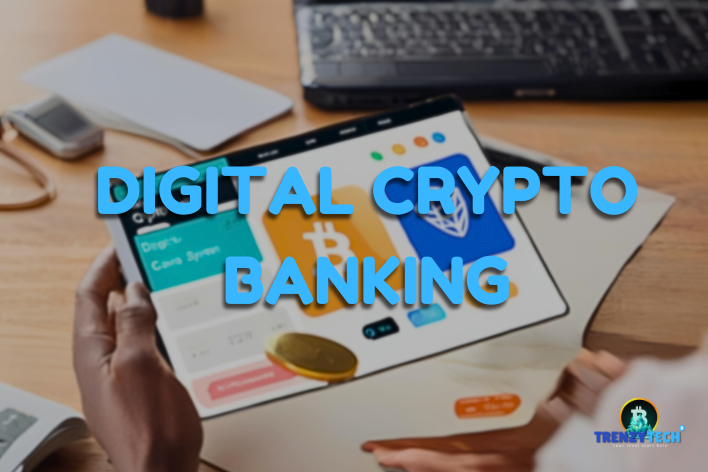Innovative Crypto Banking Solutions: What’s New and What’s Next?
Introduction:
Crypto banking is revolutionizing finance, merging blockchain innovation with traditional banking. In 2024, advancements like decentralized finance (DeFi) and central bank digital currencies (CBDCs) are set to transform the industry. This blog explores the latest innovations and trends shaping crypto banking, offering insights into the future of financial services. Whether you're a crypto enthusiast or curious about the future of banking, join us as we uncover the cutting-edge developments driving the evolution of finance.
The Rise of Decentralized Finance (DeFi) in Banking:
What is DeFi?
DeFi encompasses a range of financial applications built on blockchain networks, primarily Ethereum, that operate without traditional intermediaries such as banks and brokers. DeFi platforms use smart contracts to automate and execute financial transactions, ensuring transparency and reducing the need for intermediaries.
Key Innovations in DeFi Banking
Smart Contracts: These are self-executing contracts with the terms directly written into code, automatically enforcing agreements without intermediaries.
Decentralized Lending and Borrowing: Platforms like Aave, Compound, and newer entrants like Venus on Binance Smart Chain allow users to lend and borrow cryptocurrencies directly, earning interest or accessing capital without traditional credit checks.
Yield Farming and Staking: Users can earn rewards by providing liquidity to DeFi protocols or staking their assets. This involves depositing funds into liquidity pools or staking mechanisms to earn interest or tokens.
Decentralized Exchanges (DEXs): Platforms like Uniswap, SushiSwap, and PancakeSwap facilitate peer-to-peer trading of cryptocurrencies without a central authority, offering a more decentralized trading experience.
Advantages of DeFi in Banking
Transparency: Transactions are recorded on public blockchains, ensuring transparency and reducing fraud risks.
Accessibility: DeFi platforms are accessible to anyone with an internet connection, providing financial services to unbanked and underbanked populations globally.
Cost Efficiency: By eliminating intermediaries, DeFi reduces transaction fees and processing times, making financial services more affordable.
Latest Developments and Examples
Aave: Continues to be a leading decentralized lending platform, recently integrating with traditional financial institutions to offer DeFi services.
Uniswap: A top decentralized exchange, now incorporating layer 2 solutions like Optimistic Rollups to improve transaction speeds and reduce fees.
MakerDAO: Maker continues to evolve its stablecoin DAI, integrating with multiple blockchains for broader access and increased stability.
Venus Protocol: An emerging DeFi lending platform on Binance Smart Chain, offering high yields and low fees compared to Ethereum-based counterparts.
Central Bank Digital Currencies (CBDCs):
Global Developments
China's Digital Yuan: China continues to lead the way with its Digital Yuan (e-CNY). The People's Bank of China (PBOC) has expanded pilot programs to more cities and increased the scope of use cases, including retail transactions, government payments, and cross-border trade. The integration of the Digital Yuan with major e-commerce platforms like Alibaba and Tencent has significantly boosted adoption.
European Central Bank (ECB): The ECB is in the advanced stages of developing the Digital Euro. After extensive public consultations and technical studies, the ECB plans to launch a pilot program in selected Eurozone countries. The focus is on providing a secure and efficient digital payment option while ensuring privacy and resilience against cyber threats.
US Federal Reserve: The Federal Reserve is exploring the potential of a Digital Dollar. In 2024, the Fed has launched a series of research initiatives and pilot programs in collaboration with financial institutions and technology firms to assess the feasibility, benefits, and risks associated with a Digital Dollar.
Bank of Japan: The Bank of Japan (BoJ) has accelerated its CBDC research and development efforts. Following successful preliminary trials, the BoJ is now conducting extensive pilot programs to test the Digital Yen's functionality and integration with existing financial systems.
Impact on the Financial System
Financial Inclusion: CBDCs have the potential to enhance financial inclusion by providing digital financial services to unbanked and underbanked populations. Central banks are designing CBDCs to be accessible via smartphones and other digital devices, making financial services more widely available.
Banking Sector Dynamics: The introduction of CBDCs is likely to impact commercial banks, particularly in the areas of deposit mobilization and payment services. Banks may need to innovate and adapt their business models to remain competitive in a CBDC-dominated landscape.
Challenges and Considerations
Regulatory Frameworks: Developing appropriate regulatory frameworks for CBDCs is crucial to ensure their safe and effective implementation. Central banks are working closely with regulators and policymakers to address legal, operational, and cybersecurity challenges.
Public Adoption: Achieving widespread public adoption of CBDCs requires addressing concerns related to privacy, security, and ease of use. Central banks are investing in public education campaigns and user-friendly interfaces to build trust and encourage adoption.
Economic Implications: The introduction of CBDCs could have broad economic implications, including impacts on money supply, interest rates, and the traditional banking system. Central banks are conducting extensive economic analyses to understand and mitigate potential risks.
Interoperability and Cross-Chain Solutions:
What is Interoperability and Cross-Chain Solutions?
Interoperability refers to the ability of different blockchain networks to communicate, share data, and execute transactions across diverse platforms. Cross-Chain Solutions are technologies and protocols designed to facilitate this communication and interaction between separate blockchain ecosystems.
Key Innovations in Interoperability and Cross-Chain Solutions
Cross-Chain Protocols
Polkadot: Polkadot is a leading cross-chain platform developed by Parity Technologies. It uses a relay chain architecture to enable different blockchains, called parachains, to interoperate and share information. Recent updates include the launch of Polkadot 2.0, which enhances scalability and interoperability with more blockchains.
Cosmos: Cosmos provides a framework for building interconnected blockchain networks. The Inter-Blockchain Communication (IBC) protocol facilitates secure data transfer and token swaps across different blockchains. Recent developments include the expansion of the Cosmos Hub and integration with new projects.
Bridges and Wrapping Solutions
Chainlink CCIP: Chainlink’s Cross-Chain Interoperability Protocol (CCIP) allows for secure and decentralized cross-chain communication. Recent updates include the integration of CCIP with major DeFi platforms to support cross-chain smart contract execution and token transfers.
Thorchain: Thorchain is a decentralized liquidity protocol that supports cross-chain swaps and transfers. Recent enhancements include increased support for additional assets and improved liquidity mechanisms.
Advantages of Cross-Chain Solutions
Increased Liquidity: Cross-chain solutions enable the movement of assets between different blockchains, increasing liquidity in the DeFi ecosystem.
Broader Access to Services: Users can access a wider range of services and products by interacting with multiple blockchain platforms.
Enhanced Flexibility: Supports the creation of complex financial products and services that utilize the strengths of different blockchain networks.
Challenges and Considerations
Security Risks: Cross-chain solutions can introduce new attack vectors and vulnerabilities. Ensuring robust security measures is essential for protecting assets and data.
Complexity: Interoperability solutions often involve complex technical implementations and require careful management of different blockchain protocols.
Scalability: Ensuring that cross-chain solutions can scale effectively to accommodate growing user bases and transaction volumes is a key challenge.
Expansion of Crypto Payment Solutions:
Recent Trends and Developments
1. Increased Merchant Adoption
Major Retailers Accepting Crypto
Starbucks: Starbucks has expanded its crypto payment options through partnerships with Flexa and BitPay. Customers can now pay with Bitcoin, Ethereum, and other major cryptocurrencies at Starbucks locations.
Example: Starbucks customers can use the Starbucks app integrated with Flexa to scan a QR code and pay with Bitcoin or Ethereum.
Tesla: Tesla has reintroduced cryptocurrency payments for its vehicles. This option allows customers to purchase Tesla cars using Bitcoin, following updates to their payment policies.
Example: Tesla buyers can complete their purchase using Bitcoin via a dedicated payment gateway provided by BitPay.
Amazon: Amazon has started accepting crypto payments through third-party services like BitPay and Coinbase Commerce for certain products and services.
Example: Amazon customers can pay for select goods using Bitcoin through BitPay.
2. Innovations in Payment Gateways and Processing
New Payment Gateways and Services
Coinbase Commerce: Coinbase Commerce has introduced features for merchants to accept multiple cryptocurrencies, including Bitcoin, Ethereum, and stablecoins.
Recent Update: Coinbase Commerce now supports USDC and Dai for transactions, expanding the range of acceptable cryptocurrencies.
BitPay: BitPay has enhanced its services with features such as auto-conversion of crypto payments to local currencies and improved integration options for merchants.
Recent Update: BitPay now offers Bitcoin Lightning Network payments for faster and cheaper transactions.
MoonPay: MoonPay offers a seamless on-ramp for buying cryptocurrencies with traditional payment methods. Recent developments include integrations with new e-commerce platforms and services.
Recent Update: MoonPay has added support for Apple Pay and Google Pay, making it easier for users to purchase crypto.
Conclusion:
As we advance through 2024, the landscape of crypto banking is undergoing a profound transformation. Innovations such as the rise of DeFi, the development of CBDCs, and the expansion of crypto payment solutions are shaping the future of finance. By staying informed about these trends, you can better navigate the evolving world of digital banking and seize new opportunities in the financial sector.





